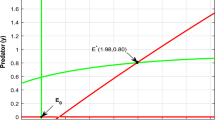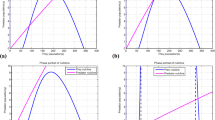Abstract
A three-component model consisting on one-prey and two-predator populations is considered with a Holling type II response function incorporating a constant proportion of prey refuge. We also consider the competition among predators for their food (prey) and shelter. The essential mathematical features of the model have been analyzed thoroughly in terms of stability and bifurcations arising in some selected situations. Threshold values for some parameters indicating the feasibility and stability conditions of some equilibria are determined. The range of significant parameters under which the system admits different types of bifurcations is investigated. Numerical illustrations are performed in order to validate the applicability of the model under consideration.





Similar content being viewed by others
References
Cressman, R., Garay, J.: A predator–prey refuge system: evolutionary stability in ecological systems. Theor. Popul. Biol. 76, 248–257 (2009)
Ray, S., Straskraba, M.: The impact of detritivorous fishes on a mangrove estuarine system. Ecol. Model. 140, 207–218 (2001)
Gonzalez-Olivares, E., Ramos-Jiliberto, R.: Dynamics consequences of prey refuge in a simple model system: more prey and few predators and enhanced stability. J. Ecol. Model. 166, 135–146 (2003)
Connell, J.H.: Community interactions on marine rocky intertidal shores. Annu. Rev. Ecol. Syst. 3, 169–192 (1972)
Murdoch, W.W., Oaten, A.: Predation and population stability. Adv. Ecol. Res. 9, 1–31 (1975)
Hassell, M.P., May, R.M.: Stability in insect host–parasite models. J. Anim. Ecol. 42, 693–726 (1973)
Hassell, M.P.: The Dynamics of Arthropod Predator–Prey Systems. Princeton University Press, Princeton, NJ (1978)
Holling, C.S.: The components of predation as revealed by a study of small mammal predation of the European pine sawfly. Can. Entomol. 91, 293–320 (1959)
Holling, C.S.: Some characteristics of simple types of predation and parasitism. Can. Entomol. 91, 385–395 (1959)
Hoy, M.A.: Almonds (California). In: Helle, W., Sabelis, M.W. (eds.) Spider Mites: Their Biology, Natural Enemies and Control. World Crop Pest, vol. 1B, pp. 229–310. Elsevier, Amsterdam (1985)
Huang, Y., Chen, F., Zhongs, L.: Stability analysis of prey–predator model with Holling type III response function incorporating a prey refuge. J. Appl. Math. Comput. 182, 672–683 (2006)
Smith, M.: Models in Ecology. Cambridge University Press, Cambridge (1974)
Collings, J.B.: Bifurcation and stability analysis of temperature-dependent mite predator–prey interaction model incorporating a prey refuge. J. Math. Biol. 57, 63–76 (1995)
Freedman, H.I.: Deterministic Mathematical Method in Population Ecology. Marcel Dekker, New York (1980)
Hochberg, M.E., Holt, R.D.: Refuge evolution and the population dynamics of coupled of host–parasitoid associations. J. Evol. Ecol. 9, 633–661 (1995)
Kar, T.K.: Stability analysis of a prey-predator model incorporating a prey refuge. Commun. Nonlinear Sci. Numer. Simul. 10, 681–691 (2005)
Krivan, V.: Effect of optimal antipredator behaviour of prey on predator–prey dynamics: the role of refuge. Theor. Popul. Biol. 53, 131–142 (1998)
May, R.M.: Stability and Complexity in Model Ecosystem. Princeton University Press, Princeton (1974)
McNair, J.N.: The effect of refuge on prey–predator interactions: a reconsideration. Theor. Popul. Biol. 29, 38–63 (1986)
Ruxton, G.D.: Short-term refuge use and stability of predator–prey model. Theor. Popul. Biol. 47, 1–17 (1995)
Sih, A.: Prey refuge and predator–prey stability. Theor. Popul. Biol. 31, 1–12 (1987)
Taylor, R.I.: Predation. Chapman and Hall, New York (1984)
Holling, C.S.: The functional response of predator to prey density and its role in mimicry and population regulations. Mem. Entomol. Soc. Can. 45, 3–60 (1965)
Hethcote, H.W., Wang, W., Ma, Z.: A predator prey model with infected prey. Theor. Popul. Biol. 66, 259–268 (2004)
Inaba, H., Nishiura, H.: The basic reproduction number of an infectious disease in a stable population: the impact of population growth rate on the eradication threshold. Math. Model. Nat. Phenom. 3, 194–228 (2008)
Haque, M., Venturino, E.: Increase of the prey may decrease the healthy predator population in presence of a disease in the predator. Hermis 7, 39–60 (2006)
Birkhoff, G., Rota, G.C.: Ordinary Differential Equations. Ginn, Boston (1982)
Haque, M., Venturino, E.: The role of transmissible diseases in the Holling–Tanner predator–prey model. Theor. Popul. Biol. 70, 273–288 (2006)
Sotomayor, J.: Generic bifurcations of dynamical systems. In: Peixoto, M.M. (eds.) Dynamical Systems, pp. 549–560. Academic Press, New York (1973)
Rudin, W.: Principles of Mathematical Analysis, vol. 3. McGraw-Hill, New York (1976)
Hale, J.K.: Ordinary Differential Equations. Krieger (Publishing Co.), Malabar (1989)
Gakkhar, S., Singh, B., Naji, R.K.: Dynamical behavior of two predators competing over a single prey. Biosystems 90, 808–817 (2007)
Li, Y., Muldowney, S.: On Bendixson criteria. J. Differ. Equ. 106, 27–39 (1993)
Freedman, H.I., Waltman, P.: Persistence in models of three interacting predator–prey populations. Math. Biosci. 68, 213–231 (1984)
Anderson, T.W.: Predator responses, prey refuges, and density-dependent mortality of a marine fish. Ecology 82, 245–257 (2001)
Magalhaes, S., van Rijn, P.C.J., Montserrat, M., Pallini, A., Sabelis, M.W.: Population dynamics of thrips prey and their mite predators in a refuge. Oecologia 150, 557–568 (2007)
Menezes, L.C.C.R., Rossi, M.N., Godoy, W.A.C.: The effect of refuge on dermestes ater (Coleoptera: Dermestidae) Predation on Musca domestica (Diptera: Muscidae): refuge for prey or the predator? J. Insect Behav. 19, 717–729 (2006)
Sarwardi, S., Mandal, P.K., Ray, S.: Analysis of a competitive prey–predator system with a prey refuge. Biosystems 110, 133–148 (2012)
Roy, M., Mandal, S., Ray, S.: Detrital ontogenic model including decomposer diversity. Ecol. Model. 215, 200–206 (2008)
Arino, O., Mikram, J., Chattopadhyay, J.: Infection on prey population may act as a biological control in ratio-dependent predator–prey model. Nonlinearity 17, 1101–1116 (2004)
Acknowledgements
The final form of the paper owes much to the helpful suggestions of the learned referees, whose careful scrutiny we are pleased to acknowledge. The authors appreciate Prof. Santabrata Chakravarty and Dr. Madan Mohan Panja, Department of Mathematics, Visva-Bharati, for their generous help in revising the manuscript. The authors S. Sarwardi and P. K. Mandal gratefully acknowledge the financial support in part from the Special Assistance Programme (SAP-II) sponsored by the University Grants Commission (UGC), New Delhi, India. Santanu Ray is thankful to the Department of Zoology, Visva-Bharati University, for the opportunity to perform the present work. The authors are thankful to Prof. Somdatta Mandal, Department of English, Visva-Bharati University for evaluating and correcting the English language of this paper.
Author information
Authors and Affiliations
Corresponding author
Appendices
Appendix A
The definition of the second additive compound matrix can be found in the paper of Li and Muldowney [33]. Let A = (a ij ) be an n ×n matrix. The second additive compound A [2] is the \(\left( {_2^n } \right)\times \left( {_2^n } \right)\) matrix defined as follows:
For any integer \(i = 1, {\ldots}, \left( {_2^n } \right)\), let (i) = (i 1, i 2) be the ith member in the lexicographic ordering of integer pairs (i 1, i 2), such that, 1 ≤ i 1 < i 2 ≤ n.
Then the element in the ith row and jth column of A [2] is
-
\(a_{i_{1}}{_{i_{1}}} +a_{i_{2}}{_{i_{2}}},\) if (i) = (j )
-
\(\left( {-1} \right)^{r+s}a_{i_{r}j_{\,s}},\) if exactly one entry i r of (i) doesn’t occur in (j ) and j s doesn’t occur in (j )
-
0, if neither entry from (i) occurs in (j )
For n = 3
its second additive compound matrix is
In this case, (1) = (1, 2), (2) = (1, 3), (3) = (2, 3).
Appendix B
Theorem 11
Bendixson’s criterion in R n (cf. Arino et al. [40]): A simple closed rectifiable curve that is invariant with respect to (11) cannot exist if any one of the following conditions is satisfied in R n :
-
(i)
\({\sup \left\{ {\dfrac{\partial F_r }{\partial x_r }+\dfrac{\partial F_s }{\partial x_s }+\displaystyle\sum\limits_{j\,\ne\, r,s} {\left( {\left| {\dfrac{\partial F_j }{\partial x_r }} \right|+\left| {\dfrac{\partial F_j }{\partial x_s }} \right|} \right):1\le r<s\le n} } \right\}<0,} \)
-
(ii)
\({\sup \left\{ {\dfrac{\partial F_r }{\partial x_r }+\dfrac{\partial F_s }{\partial x_s }+\displaystyle\sum\limits_{j\,\ne\, r,s} {\left( {\left| {\dfrac{\partial F_r }{\partial x_j }} \right|+\left| {\dfrac{\partial F_s }{\partial x_j }} \right|} \right):1\le r<s\le n} } \right\}<0,}\)
-
(iii)
λ 1 + λ 2 < 0,
-
(iv)
\({\inf \left\{ {\dfrac{\partial F_r }{\partial x_r }+\dfrac{\partial F_s }{\partial x_s }+\displaystyle\sum\limits_{j\,\ne\, r,s} {\left( {\left| {\dfrac{\partial F_j }{\partial x_r }} \right|+\left| {\dfrac{\partial F_j }{\partial x_s }} \right|} \right):1\le r<s\le n} } \right\}<0,}\)
-
(v)
\({\inf \left\{ {\dfrac{\partial F_r }{\partial x_r }+\dfrac{\partial F_s }{\partial x_s }+\displaystyle\sum\limits_{j\,\ne\, r,s} {\left( {\left| {\dfrac{\partial F_r }{\partial x_j }} \right|+\left| {\dfrac{\partial F_s }{\partial x_j }} \right|} \right):1\le r<s\le n} } \right\}<0,}\)
-
(vi)
λ n − 1 + λ n < 0,
where λ 1 ≥ λ 2 ≥ ⋯ ≥ λ n are eigenvalues of \(\frac{1}{2}\left( {\left( {{\partial F} \mathord{\left/ {\vphantom {{\partial F} {\partial x}}} \right. \kern-\nulldelimiterspace} {\partial x}} \right)^\ast +\left( {{\partial F} \mathord{\left/ {\vphantom {{\partial F} {\partial x}}} \right. \kern-\nulldelimiterspace} {\partial x}} \right)} \right)\) . \({{\partial F} \mathord{\left/ {\vphantom {{\partial F} {\partial x}}} \right. \kern-\nulldelimiterspace} {\partial x}} \) is the Jacobian matrix of F and the asterisk denotes the transposition.
Rights and permissions
About this article
Cite this article
Sarwardi, S., Mandal, P.K. & Ray, S. Dynamical behaviour of a two-predator model with prey refuge. J Biol Phys 39, 701–722 (2013). https://doi.org/10.1007/s10867-013-9327-7
Received:
Accepted:
Published:
Issue Date:
DOI: https://doi.org/10.1007/s10867-013-9327-7
Keywords
- Population models
- Prey refuge
- Persistence
- Local stability
- Global stability
- Limit cycles
- Switching of periodic solutions




